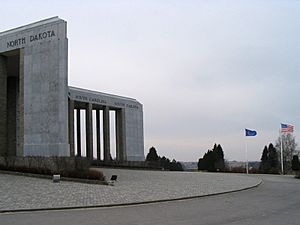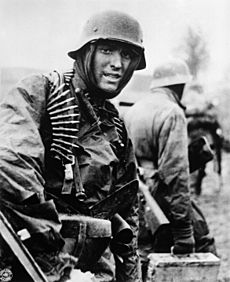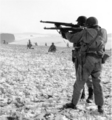Battle of the Bulge facts for kids
Quick facts for kids Battle of the Bulge |
|||||||
|---|---|---|---|---|---|---|---|
| Part of World War II | |||||||
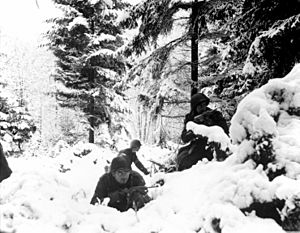 American soldiers of the 290th Infantry Regiment 75th Division photographed in the Ardennes during the Battle of the Bulge. {Amonines, Belgium 4 January 1945} |
|||||||
|
|||||||
| Belligerents | |||||||
| United States United Kingdom Canada Free French Free Belgian Forces Luxembourgish resistance |
|||||||
| Commanders and leaders | |||||||
|
Dwight D. Eisenhower |
Adolf Hitler |
||||||
| Strength | |||||||
|
840,000+ men, |
200,000 – 500,000 men 1,900 artillery guns and Nebelwerfers |
||||||
| Casualties and losses | |||||||
|
1,408 (200 killed, 1,200 wounded or missing) |
67,200 – 100,000 killed, missing/captured, or wounded ~600 tanks and assault guns |
||||||
| approximately 3,000 civilians killed | |||||||
The Battle of the Bulge was a major battle during World War II. It took place between the Allied Powers and Nazi Germany. The fighting happened from mid-December 1944 to late January 1945.
Contents
Why the Battle Happened
By the end of 1944, the Allies had taken back much of France and Belgium from Germany. However, their advance had slowed down for a few reasons:
- The Allies had very long supply lines (routes for food, weapons, and other supplies).
- They had trouble crossing the Rhine river.
- There were tough battles in the Ardennes forests, where American soldiers faced many losses.
- Bad winter weather meant Allied airplanes could not help the soldiers on the ground.
Hitler's Last Plan
Adolf Hitler, the leader of Germany, had a plan. He wanted to push the Allied forces back from the Ardennes forests. He also hoped to recapture the important port city of Antwerp. Hitler believed this attack would show the Allies that Germany would not give up. He hoped it would make them end the war so Germany could focus on fighting the Soviet Union in the east.
However, Hitler's plan did not work. The Soviet Union's forces were getting very close to Berlin, and Germany was about to lose the war. Even though his generals disagreed, Hitler gathered his last strong soldiers for one final attack. He put together about 250,000 soldiers and 1,000 tanks.
The German Attack Begins
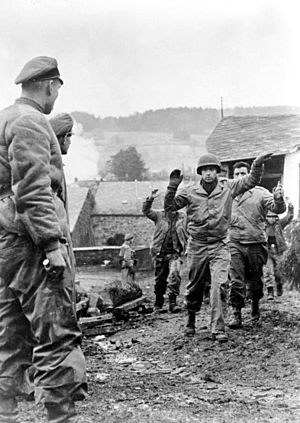
The German attack started on December 16, 1944. Three German panzer (tank) armies pushed through the Ardennes. This area was thought to be a quiet part of the front line.
The attack completely surprised the Americans. Their intelligence services had wrongly told them that the Germans in this area could not attack. Most American troops had to retreat or surrender. But in many places, the Germans made a big mistake. Their first wave of attack was mostly soldiers on foot, without enough tank support. This allowed small groups of American soldiers to hold strong in key areas. Their resistance greatly slowed the German advance. As the Americans fell back, they blew up bridges and fuel depots. This stopped the Germans from getting much-needed fuel and slowed them down even more. Bad roads also made it harder for the Germans to move quickly.
Hitler thought it would take Allied commander Dwight D. Eisenhower a few days to realize this was a major attack. But Eisenhower quickly understood the danger. On the very first day, he ordered many more troops to the area. The "Red Ball Express," which usually delivered supplies, started moving soldiers instead. Within a week, 250,000 troops were sent to the Ardennes. The 101st Airborne Division was also ordered to defend the town of Bastogne.
Meanwhile, the bad weather helped the Germans. Heavy snowstorms kept Allied airplanes on the ground for a week, from December 16 to December 23. In the north, the German attacks did not go well. Strong American resistance quickly stopped them. In the south, they had more success. However, the German soldiers were often new and inexperienced. They sometimes attacked in the open, making them easy targets for American ambushes.
Malmédy Massacre
On December 17, 1944, near a small village called Baugnez, some German soldiers from the Waffen-SS captured American soldiers. After a short fight, the Americans surrendered. Sadly, many American prisoners were killed by German soldiers. News of these killings quickly spread among the Allied forces.
Operation Greif
During the battle, a German commando named Otto Skorzeny led a special unit. This unit had 500 German soldiers who could speak English. Their mission, called Operation Greif, involved disguising themselves as American soldiers.
Some of these disguised Germans were caught. During questioning, they lied and said their mission was to go to Paris to capture or kill General Eisenhower. Because of this, security around Eisenhower became very tight, and he had to stay at his headquarters. The captured German soldiers were wearing enemy uniforms. This was against the rules of war, so they faced severe consequences, which was a standard practice during wartime.
The Siege of Bastogne
On December 19, Allied commanders met in a bunker in Verdun. Eisenhower realized that with the Germans out in the open and attacking, the Allies could defeat them more easily than if they were hiding.
By December 21, German forces had completely surrounded the town of Bastogne. The town was defended by the American 101st Airborne Division. Conditions inside Bastogne were very difficult. Many medical supplies and staff had been captured. But even with strong German attacks, the American defenses held.
The German tactics during the siege of Bastogne were not good. Instead of attacking all around the town at once, they would attack one spot, then another, then another. This allowed the Americans to move their troops to defend each attack. Even though the Germans had more soldiers, they could not break through the American lines.
On December 23, the weather cleared up. Allied airplanes could finally fly again. They dropped much-needed supplies into Bastogne, including medicine, food, blankets, ammunition, and artillery shells. A team of volunteer surgeons even flew in by glider to help the wounded. Elsewhere, Allied P-47 planes attacked German tanks, stopping the German army's movement.
The American Counter-attack
By December 24, the German advance had mostly stopped before reaching the Meuse River. They had moved too far from their supply bases, and they were running low on fuel and ammunition. General George S. Patton's Third Army was now fighting to free Bastogne. At 4:50 PM on December 26, the first tanks of the Fourth Armored Division reached Bastogne, ending the siege.
On January 1, the Germans tried two new attacks to keep their offensive going. The Luftwaffe (German air force) launched a big attack on Allied airfields. Thousands of German planes attacked, destroying about 180 Allied aircraft and damaging 100 more. However, the Luftwaffe lost 277 of its own planes. On the same day, Operation Northwind began, which was an attack into Alsace. This fighting covered about 150 kilometers. After twenty hard days of fighting, the Americans had to fall back, but they caused more German casualties than they suffered.
The American counter-attack was planned for January 1. Patton's Third Army in the south would attack north. General Bernard Montgomery's forces in the north would attack south. The two armies planned to meet at Houffalize.
General Eisenhower had placed American troops in the north (the 1st and 9th American Armies) under the command of British General Montgomery. Eisenhower wanted Montgomery to attack on January 1. If they had attacked quickly, they could have met Patton's army and trapped many German soldiers. But Montgomery, as was his habit, delayed the attack. He did not start until January 3.
American progress in the south was also slow, about a kilometer a day. The Germans tried their best to slow the Americans down, allowing their army to retreat in an orderly way. Much of the German army managed to escape the battle. However, they had such little fuel that many German tanks had to be left behind.
On January 7, 1945, Montgomery held a press conference. He took credit for most of the victory and said the counter-offensive was going very well, even though it was moving very slowly. Eisenhower later changed his order and put the American armies back under the command of General Omar Bradley. American troops were never again placed under British command.
The two American forces finally met on January 15, 1945. This marked the end of the Battle of the Bulge.
What Happened After
Neither the Allies nor the Germans gained or lost any land permanently. The Allies had a much larger army, so they could replace their losses. But the Germans could not replace the soldiers and equipment they had lost. The Battle of the Bulge was Germany's last major attempt to attack on the Western Front.
The Battle in Movies and Books
The Battle of the Bulge has been featured in several movies and novels. A full-length movie, Battle of the Bulge, was made in 1965. It starred Henry Fonda.
Interesting Facts About the Battle of the Bulge
- The Battle of the Bulge was also known as the Ardennes Counteroffensive.
- The name "Battle of the Bulge" came from the way the Allied front line looked on wartime news maps. It bulged inward like a swollen area.
- The German secret name for the attack was "Operation Watch on the Rhine." This was named after a German patriotic hymn.
- Some of Hitler's generals advised him not to go ahead with the attack. They thought it had only a 10% chance of success.
- The Germans lost about 120,000 soldiers, while the Allies lost about 75,000.
- Over a million Allied soldiers fought in the Battle of the Bulge.
- The battle lasted for about five weeks.
- It was the last time the Germans launched a major attack on the Western Front.
Images for kids
-
Hasso von Manteuffel led the Fifth Panzer Army in the middle attack route.
-
U.S. POWs on 22 December 1944
-
The Battle of the Bulge diorama at the Audie Murphy American Cotton Museum
-
Americans of the 101st Engineers near Wiltz, Luxembourg, January 1945
See also
 In Spanish: Batalla de las Ardenas para niños
In Spanish: Batalla de las Ardenas para niños



